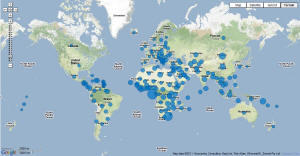| As of October 2025, the World Economic Outlook database and supporting documents will be accessible through the IMF Data portal. |

WEO Update: July 24, 2014
For the latest GDP data for the following countries please check the "Projected % Change" table in the left column of the individual country pages:
Download WEO Data: April 2014 Edition
The World Economic Outlook (WEO) database contains selected macroeconomic data series from the statistical appendix of the World Economic Outlook report, which presents the IMF staff's analysis and projections of economic developments at the global level, in major country groups and in many individual countries. The WEO is released in April and September/October each year.
Use this database to find data on national accounts, inflation, unemployment rates, balance of payments, fiscal indicators, trade for countries and country groups (aggregates), and commodity prices whose data are reported by the IMF.

Data are available from 1980 to the present, and projections are given for the next two years. Additionally, medium-term projections are available for selected indicators. For some countries, data are incomplete or unavailable for certain years.
World Economic Outlook on Google Public Data Explorer offers select indicators from the latest online WEO database, such as GDP growth and inflation.
Changes to the April 2014 Database
- On January 1, 2014, Latvia became the 18th country to join the euro area. Data for Latvia are not included in the euro area aggregates, because the database has not yet been converted to euros, but are included in data aggregated for advanced economies.
- Starting with the April 2014 WEO, the Central and Eastern Europe and Emerging Europe regions have been renamed Emerging and Developing Europe. The Developing Asia region has been renamed Emerging and Developing Asia.
- Projections for Ukraine are excluded due to the ongoing crisis.
- The consumer price projections for Argentina are excluded because of a structural break in the data. Please refer to note 6 in Table A7 of the April 2014 WEO for further details.
- Korea’s real GDP series is based on the reference year 2005. This does not reflect the revised national accounts released on March 26, 2014, after the WEO was finalized for publication. These comprehensive revisions include implementing the 2008 System of National Accounts and updating the reference year to 2010. As a result of these revisions, real GDP growth in 2013 was revised up to 3 percent from 2.8 percent (which is the figure included in Tables 2.3 and A2 of the April 2014 WEO).
- Cape Verde is now called Cabo Verde.
- As in the October 2013 WEO, data for Syria are excluded for 2011 onward because of the uncertain political situation.





